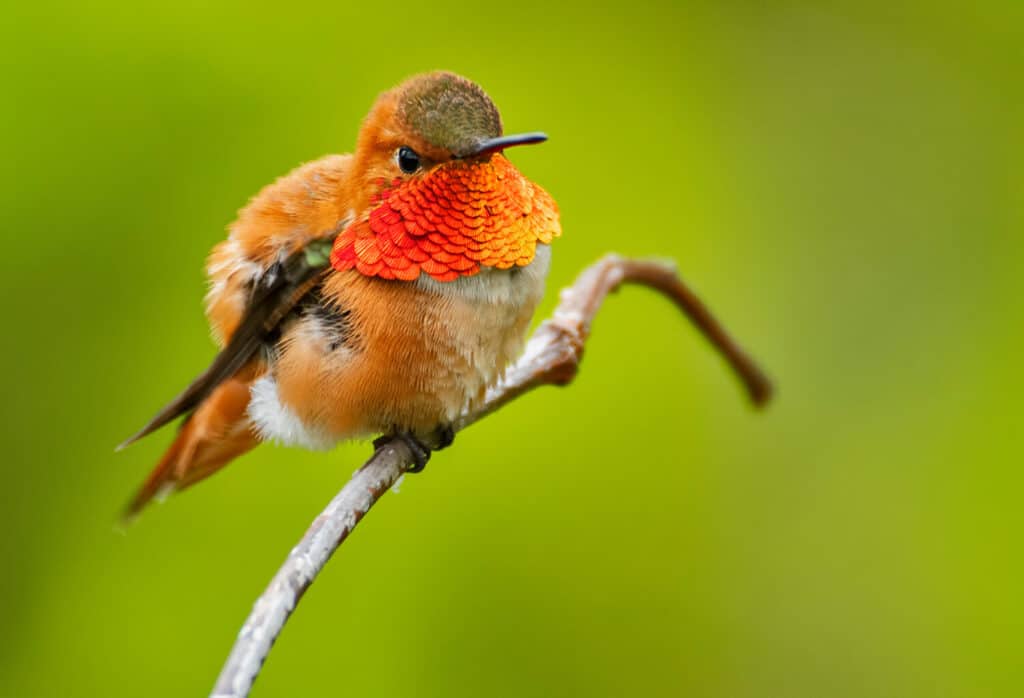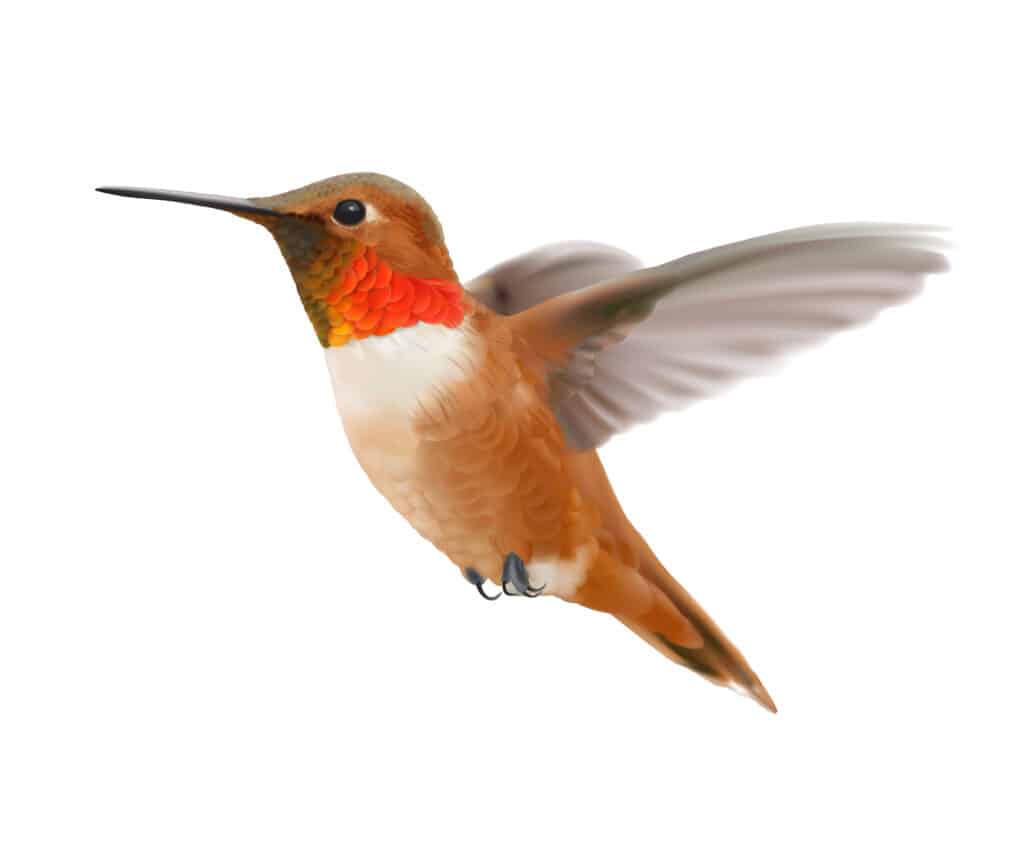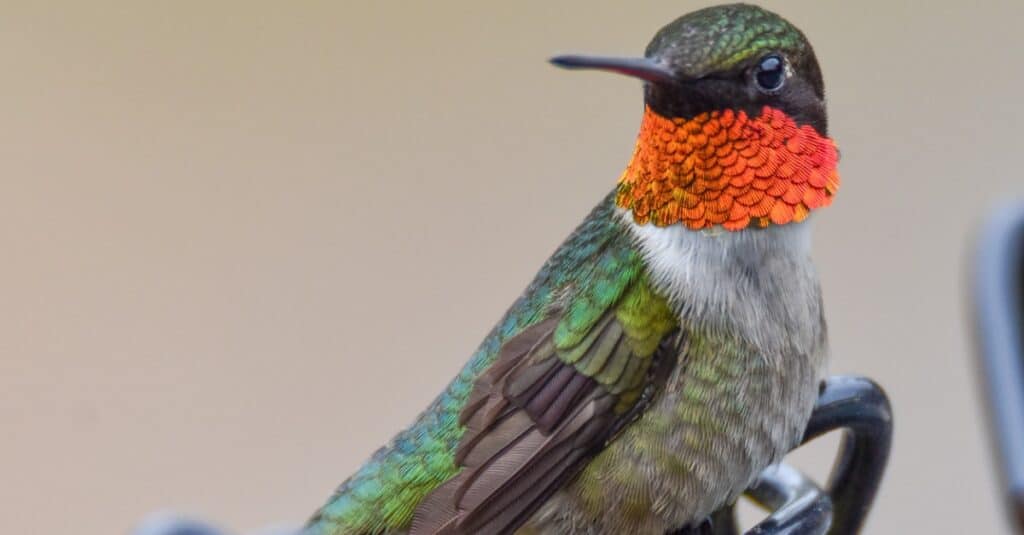As summer comes to an end and fall approaches, many nature enthusiasts in Maryland wonder when they’ll have to say goodbye to the tiny, colorful hummingbirds that visit their gardens and feeders. These fascinating birds travel long distances each year to reach their wintering grounds in warmer climates. In this article, we explore when hummingbirds flee Maryland, along with where they go. We also provide you with insights on how to make the most of your time with these magnificent creatures before they embark on their journey south.
When Do Hummingbirds Leave Maryland?

Rufous hummingbirds migrate from Maryland toward the end of August to go someplace warmer.
©punkbirdr/Shutterstock.com
Hummingbirds typically flee Maryland by the end of August or early September, with almost all birds gone by mid-September. Ruby-throated hummingbirds, the most commonly seen species in the state, arrive in mid-April and depart by late October. Rufous hummingbirds may also visit Maryland and sometimes winter there, arriving in September and departing in late April.
Hummingbird Migratory Patterns

Ruby-throated hummingbirds are one of two species of
hummingbird
residing in Maryland.
©Al Mueller/Shutterstock.com
Hummingbirds have a specific migratory pattern in Maryland, with the ruby-throated hummingbird being the only species that breeds in the area. Male hummingbirds usually arrive in mid-to-late April, with females arriving in the first or second week of May. They then start their breeding rituals.
Hummingbirds flee Maryland by the end of August or early September, with almost all birds gone by mid-September. They start their 1000-mile (1600-km) migration south to spend the winter in Florida, Mexico, or other countries in Central America. Occasionally, other species of hummingbirds, such as Rufous hummingbirds, have migrated through Maryland.
Why Do Hummingbirds Leave Maryland?

Rufous hummingbirds are one of two types of hummingbirds residing in Maryland.
©Aniko Gerendi Enderle/Shutterstock.com
Hummingbirds flee Maryland as part of their natural migration patterns. There are a few reasons why they embark on this journey:
Food availability: Hummingbirds rely heavily on nectar as their primary food source. As the seasons change and flowers wither, the availability of nectar decreases. This scarcity of food prompts hummingbirds to migrate to areas where nectar-rich flowers are still in bloom.
Weather changes: Hummingbirds are sensitive to temperature and weather conditions. As the weather begins to cool in Maryland, it becomes less favorable for these tiny birds. They migrate south to find more temperate climates where they can thrive.
Daylight hours: Hummingbirds have a keen sense of the changing daylight hours. As the days grow shorter in Maryland, it triggers their instinct to migrate. They can sense the reduced daylight as a signal to begin their journey to warmer regions.
Breeding season: Once the breeding season is complete, hummingbirds have fulfilled their reproductive responsibilities. With no further need to remain in Maryland, they depart for their wintering grounds.
Overall, the combination of diminishing food sources, changing weather, decreasing daylight hours, and the completion of their breeding cycle leads hummingbirds to leave Maryland and embark on their impressive migrations to more favorable habitats.
Where Do Hummingbirds Migrate?

The
ruby-throated hummingbird
migrates to Central America
©Agnieszka Bacal/Shutterstock.com
Hummingbirds in Maryland migrate to various locations for the winter, depending on the species. The main species of hummingbirds that migrate in Maryland are the ruby-throated hummingbird and the Rufous hummingbird. The most commonly seen species in Maryland, the ruby-throated hummingbird, migrates to Central America, particularly Southern Mexico and countries in Central America, to spend the winter.
Other species, such as the Rufous hummingbird, may also pass through Maryland during their migration and are in different regions of North America, including the western coast and parts of Mexico. It’s important to note that individual hummingbirds may have slightly different migration paths and destinations within these general patterns.
Are There Any Species of Hummingbirds in Maryland That Don’t Migrate?

Ruby-throated hummingbirds have a beautiful ruby color on their throats.
©iStock.com/Jessica Maruszewski
There have been records of other hummingbird species occasionally in the area during migration, apart from the Rufous and ruby-throated hummingbirds. It’s important to note that some species of hummingbirds, like Anna’s hummingbird, Costa’s hummingbird, broad-billed hummingbird, and buff-bellied hummingbird, are non-migratory and may choose to stay in certain regions year-round. However, these non-migratory species are more common in areas like Washington, Oregon, California, Arizona, Louisiana, Mississippi, and Vancouver Island.
How Can I Attract Hummingbirds to My Backyard?

Hummingbird feeders are the best way to attract hummingbirds in your yard.
©Eleanor McDonie/Shutterstock.com
To attract hummingbirds to your backyard in Maryland, you can follow these tips:
Plant tubular flowers: Planting tubular flowers like bee balm or trumpet creeper can help attract hummingbirds. Their long, thin beaks are perfect for accessing the nectar deep inside these tubular blooms.
Use nectar feeders: Supplement the natural food sources in your area by setting up nectar feeders specifically designed for hummingbirds. Fill them with a solution of four parts water to one-part white granulated sugar. Avoid using honey or artificial sweeteners, as they can be harmful to hummingbirds.
Choose red-colored feeders and flowers: Hummingbirds love the color red. Opt for red-colored feeders and plant red flowers in your garden to catch their attention.
Provide a water source: Hummingbirds need water not only for drinking but also for bathing. Place a shallow birdbath or a misting feature in your backyard to provide them with a water source.
Create a hummingbird-friendly habitat: Include a variety of trees, shrubs, vines, and flowers in your garden that bloom from mid-April throughout the summer. This will provide a diverse and continuous food supply for hummingbirds.
Maintain cleanliness: Keep your nectar feeders and birdbaths clean and free from mold or debris. Change the nectar solution every three to four days, especially in hot weather, to prevent spoilage.
By following these tips, you can create an inviting environment for hummingbirds and increase the chances of attracting them to your backyard in Maryland. Take down hummingbird feeders in the second week of October, or two weeks after seeing the last hummingbird using the feeders.
The photo featured at the top of this post is © John L. Absher/Shutterstock.com
Thank you for reading! Have some feedback for us? Contact the AZ Animals editorial team.







